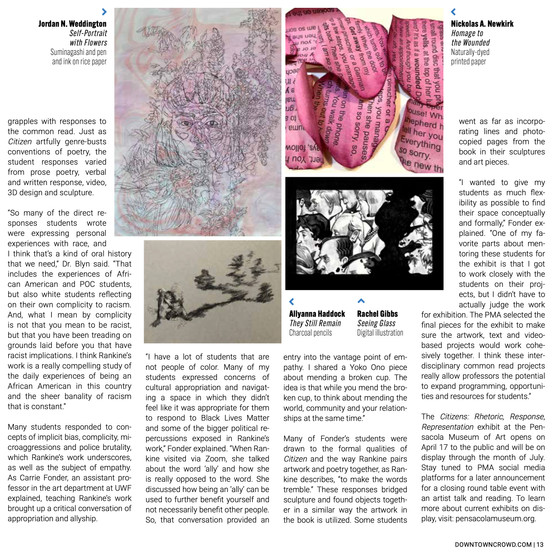By Dakota Parks for Downtown Crowd
Art has the power to connect, inspire and spark critical discourse through historical and social movements. When more than 20 classes at the University of West Florida set out on a common read of poet Claudia Rankine’s book Citizen: An American Lyric, students began responding to the work in a wide variety of mediums. More than 700 students and community members tuned in to Rankine’s virtual lecture and visit in February hosted by the UWF Downtown Lecture series. Rankine’s book intertwines poetry, lyrical essay and visual art to create a collective portrayal of racial relations in the U.S. and day-to-day microaggressions experienced by African Americans. The “Citizens: Rhetoric, Response, Representation” exhibit at the Pensacola Museum of Art (PMA) opens on April 17 and will display an interdisciplinary display of student responses.
“The common read of Citizen emerged as a response to the events of last summer,” Dr. Robin Blyn, English professor at The University of West Florida explained. “In particular, to the number of people out in the streets protesting the deaths of African Americans at the hands of police. There was an overwhelming sense that there were conversations that needed to be had about race. A lot of students at UWF wanted to talk about it and needed to talk about it. Artwork and literature both provide us with the room to talk about things that we couldn’t otherwise talk about in depth without feeling threatened.”
As Dr. Blyn explained, more than 20 classes collaborated at UWF from composition courses, creative writing, literature, feminist theory and several art classes such as 3D design and a BFA seminar course to read, teach and respond to Rankine’s book. The English Department collaborated with the Art Department to host an exhibit of student work at the PMA that grapples with responses to the common read. Just as Citizenartfully genre-busts conventions of poetry, the student responses varied from prose poetry, verbal and written response, video, 3D design and sculpture.
“So many of the direct responses students wrote were expressing personal experiences with race, and I think that’s a kind of oral history that we need,” Dr. Blyn said. “That includes the experiences of African American and POC students, but also white students reflecting on their own complicity to racism. And, what I mean by complicity is not that you mean to be racist, but that you have been treading on grounds laid before you that have racist implications. I think Rankine’s work is a really compelling study of the daily experiences of being an African American in this country and the sheer banality of racism that is constant.”
Many students responded to concepts of implicit bias, complicity, microaggressions and police brutality, which Rankine’s work underscores, as well as the subject of empathy. As Carrie Fonder, an assistant professor in the art department at UWF explained, teaching Rankine’s work brought up a critical conversation of appropriation and allyship.
“I have a lot of students that are not people of color. Many of my students expressed concerns of cultural appropriation and navigating a space in which they didn’t feel like it was appropriate for them to respond to Black Lives Matter and some of the bigger political repercussions exposed in Rankine’s work,” Fonder explained. “When Rankine visited via Zoom, she talked about the word ‘ally’ and how she is really opposed to the word. She discussed how being an ‘ally’ can be used to further benefit yourself and not necessarily benefit other people. So, that conversation provided an entry into the vantage point of empathy. I shared a Yoko Ono piece about mending a broken cup. The idea is that while you mend the broken cup, to think about mending the world, community and your relationships at the same time.”
Many of Fonder’s students were drawn to the formal qualities of Citizen and the way Rankine pairs artwork and poetry together, as Rankine describes, “to make the words tremble.” These responses bridged sculpture and found objects together in a similar way the artwork in the book is utilized. Some students went as far as incorporating lines and photocopied pages from the book in their sculptures and art pieces.
“I wanted to give my students as much flexibility as possible to find their space conceptually and formally,” Fonder explained. “One of my favorite parts about mentoring these students for the exhibit is that I got to work closely with the students on their projects, but I didn’t have to actually judge the work for exhibition. The PMA selected the final pieces for the exhibit to make sure the artwork, text and videobased projects would work cohesively together. I think these interdisciplinary common read projects really allow professors the potential to expand programming, opportunities and resources for students.”
The “Citizens: Rhetoric, Response, Representation” exhibit at the Pensacola Museum of Art opens on April 17 to the public and will be on display through the month of July. Stay tuned to PMA social media platforms for a later announcement for a closing round table event with an artist talk and reading. To learn more about current exhibits on display, visit: pensacolamuseum.org.




